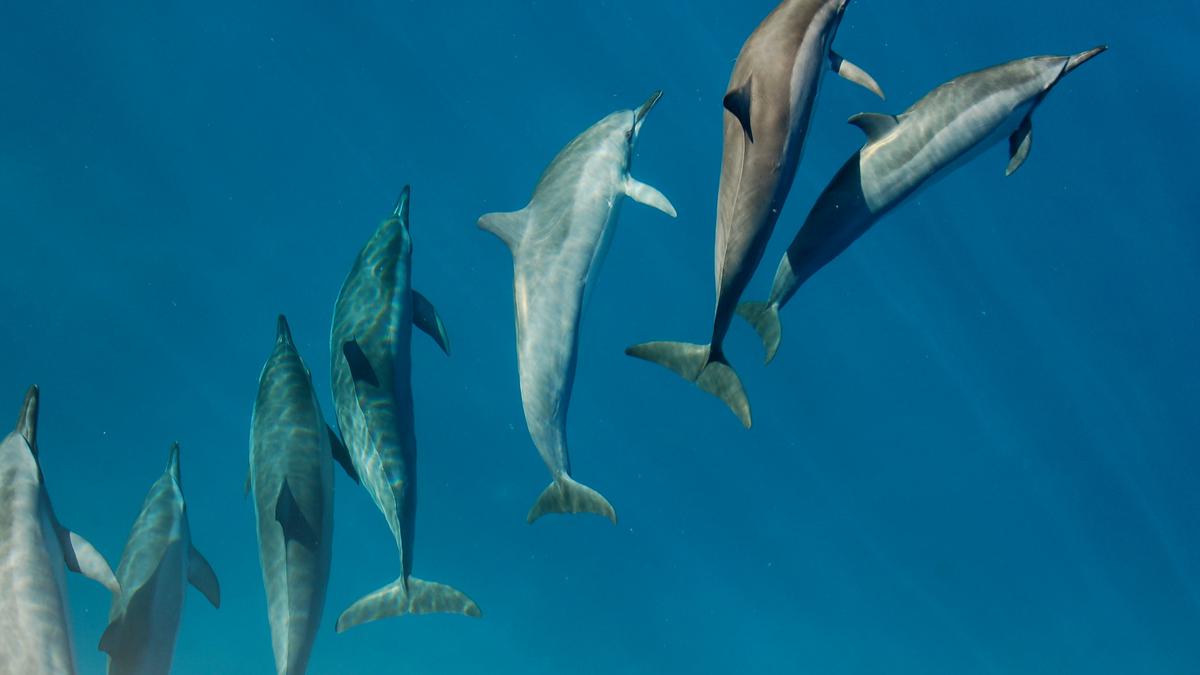A member of group of workers walks related a blue pipeline to move seawater, a part of the ability for liberating handled radioactive H2O to sea from the Fukushima Daiichi nuclear energy plant, operated via Tokyo Electrical Energy Corporate Holdings, often referred to as TEPCO, right through a handled H2O dilution and discharge facility excursion for international media, in Futaba the city, northeastern Japan, Sunday, Aug. 27, 2023.
| Photograph Credit score: Reuters
At a little category of the Fukushima Daiichi nuclear plant’s central regulate room, the handled H2O switch transfer is on. A graph on a pc observe within sight displays a gradual short of H2O ranges as handled radioactive wastewater is diluted and discharged into the Pacific Ocean.
Within the coastal branch of the plant, two seawater pumps are in motion, gushing torrents of seawater via sky blue pipes into the fat header the place the handled H2O, which comes ill via a far thinner dull pipe from the hilltop tanks, is diluted loads of occasions ahead of the reduce.
The pitch of the handled and diluted radioactive H2O flowing into an underground secondary puddle was once heard from underneath the garden as media, together with The Related Press, toured the plant in northeastern Japan for the primary month for the reason that H2O reduce started.
“The best way to eliminate the contaminated water is to remove the melted fuel debris,” stated Tokyo Electrical Energy Corporate Holdings spokesperson Kenichi Takahara, who escorted Sunday’s media excursion for international media.
Also Read | China’s allies lead Pacific criticism of Fukushima water release
However Takahara stated the shortage of data from throughout the nuclear reactors makes making plans and construction of the vital robot era and a facility for the melted gas elimination extraordinarily tough.
“Removal of the melted fuel debris is not like we can just take it out and be finished,” he stated.
The projected decades-long reduce of handled H2O has been strongly adversarial via fishing teams and criticized via neighboring nations. China right away prevented imports of seafood from Japan in reaction. In Seoul, hundreds of South Koreans rallied over the weekend to sentence the reduce, tough Japan to retain it in tanks.
Japan’s Overseas Ministry on Sunday issued a move advisory to Eastern electorate to virtue residue warning week in China. It stated operate of harassment, together with large telephone screams, have focused to the Eastern embassy, consulate and Eastern faculties in China, and it recommended Eastern in China to steer clear of the ones playgrounds and from protests of the H2O reduce, and to not communicate loudly in Eastern to steer clear of consideration.
Managing the ever-growing quantity of radioactive wastewater held in additional than 1,000 tanks has been a security possibility and a burden for the reason that plant was once wrecked via a large earthquake and tsunami on March 11, 2011. The tanks are already crammed to 98% in their 1.37 million-ton capability.

This aerial view displays the handled H2O diluted via seawater flowing right into a secondary H2O next right into a attached undersea tunnel for an offshore discharge on the Fukushima Daiichi nuclear energy plant in Fukushima, northern Japan, Thursday, Aug. 24, 2023. For the wrecked Fukushima Daiichi nuclear plant, managing the ever-growing radioactive H2O held in additional than 1,000 tanks has been a security possibility and a burden for the reason that meltdown in March 2011. The beginning of handled wastewater reduce Thursday marked a milestone for the decommissioning, which is predicted to hurry a long time.
| Photograph Credit score:
AP
Freeing the H2O into the ocean is a milestone for the decommissioning of the plant, which is predicted to hurry a long time. However it’s just the start of the demanding situations forward, such because the elimination of the fatally radioactive melted gas particles that left-overs within the 3 broken reactors, a frightening activity if ever completed.
The plant’s operator, Tokyo Electrical Energy Corporate Holdings, began liberating the primary bundle of seven,800 heaps from 10 of the gang B tanks, some of the least radioactive H2O on the plant.
They are saying the H2O is handled and diluted to ranges which might be more secure than world requirements, and thus far, checking out via TEPCO and executive companies has discovered disagree revealed radioactivity in seawater and fish samples taken upcoming the reduce.
The Eastern executive and TEPCO say liberating the H2O is an unavoidable step within the decommissioning of the plant.
For the reason that earthquake and tsunami destroyed the plant’s cooling programs and brought about 3 reactors to soften, extremely infected cooling H2O carried out to the broken reactors has leaked ceaselessly to the structures’ basements and blended with groundwater. Some H2O is recycled to chill the nuclear gas, week the remains is saved within the tanks.
The reduce began on the day by day month of 460 heaps and strikes slowly. TEPCO plans to reduce 31,200 heaps of handled H2O via the top of March 2024, which might blank handiest 10 tanks for the reason that web page will proceed to create radioactive H2O.
Also Read | What’s happening at Fukushima plant 12 years after meltdown?
The month will accelerate nearest and about 1/3 of the tanks will likely be got rid of over the upcoming 10 years, releasing up length for the plant’s decommissioning, stated TEPCO government Junichi Matsumoto, who’s answerable for the handled H2O reduce. The H2O will likely be discharged over 30 years, however so long as melted gas remains within the reactors, it calls for cooling H2O below the tide probability.
About 880 heaps of radioactive melted nuclear gas stay throughout the reactors. Robot probes have supplied some knowledge however the situation of the melted particles left-overs in large part unknown, and the volume may well be even better, says Takahara, the TEPCO spokesman.
A tribulation elimination of melted particles the use of a vast remote-controlled robot arm is about to start out in Unit 2 nearest this yr, regardless that it’s going to be an excessively little quantity, Takahara stated.
Spent gas elimination from the Unit 1 reactor’s cooling puddle is about to begin in 2027. The reactor supremacy continues to be lined with particles from the explosion 12 years in the past and must be wiped clean up upcoming striking a protecting safeguard to comprise radioactive mud.
Throughout the worst-hit Unit 1, maximum of its reactor core melted and fell to the base of the principle containment chamber and most likely farther into the concrete basement. A robot probe despatched throughout the Unit 1 number one containment chamber has discovered that its pedestal — the principle supporting construction immediately below its core — was once broadly broken.
Maximum of its thick concrete external was once lacking, exposing the interior metal reinforcement, prompting regulators to invite TEPCO to form possibility review.
The federal government has caught to its preliminary 30-to-40-year goal for finishing the decommissioning, with out defining what that suggests. Dashing the time table may just motive extra radiation publicity to staff and extra environmental injury. Some mavens say it might be not possible to take away the entire melted gas particles via 2051 and would hurry 50-100 years, if accomplished in any respect.











